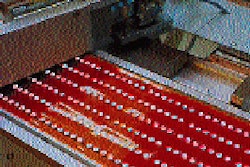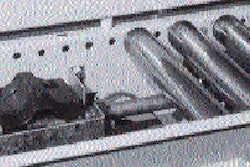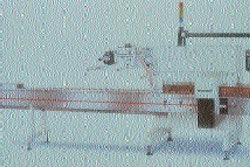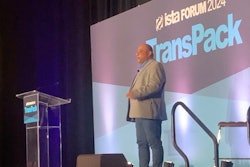Packaging for apparel and accessories is seldom challenging because the product itself does the selling. In the case of socks, however, four of every five sales are completely impulse purchases, says manufacturer Wigwam Mills, Sheboygan, WI, and in-store promotion and display packaging are big stimulators. Wigwam is a manufacturer of activewear socks that felt its packaging had become outdated and "stodgy." So in late '93, the company launched a sock packaging redesign program geared for the fall of '94, back-to-school season. In fact, it made a commitment to new packaging to both customers and its sales force. Here's what happened: * With the help of supplier Sheboygan Paper Box (Sheboygan, WI), Wigwam developed a new display package with powerful graphics. Meanwhile, the materials used are appropriately "green." But the new pack could not be labeled with existing equipment. * Thanks to a print-and-apply labeling system from Avery Dennison, Soabar (Philadelphia, PA), Wigwam labels both the front and back of the package with variable copy and variable UPC codes at speeds well beyond its previous capability. * Because labels are printed immediately before application, Wigwam gains the kind of production flexibility that allows it to easily respond to last minute order changes-or sales opportunities. * Despite not being introduced until the fall of '94, the improved packaging was seen as a spark behind a 20% increase in sales last year. * The $300ꯠ investment in upgrading sock packaging will be recovered in 18 months, and annual savings will be $50ꯠ after that. Before the change, the company packed its socks in conventional paper bands that were imprinted with variable information via a roll-to-roll hot stamper. Security and hangability were provided by a plastic "dart" and J-hook. New sleeve package The new package has a combination of attributes-including economics-that have won high praise from retailers and consumers alike. The concept came from Ray Gummer, marketing services manager, when he combined the best of an existing pack in Wigwam's line with the top of a two-piece photofinisher's box. It's so unique that the company has applied for a design patent on it. The package is all paperboard, a 16-pt two-side clay-coated newsback. It replaces not only the paper band, but also the plastic dart and J-hook. "Replacing the plastic parts was important to us because consumers told us they didn't like them," Gummer says. "Sometimes people actually damage the socks when they try to get the dart out of the package." The newsback is 100% recycled paper, at least 35% of it post-consumer, according to the supplier. And the paperboard package can be recycled after use. That, too, was mentioned as being important to consumers, Gummer says. Aiding in that, Sheboygan Paper Box uses water-based inks, varnish and adhesive in creating the sleeve. The new packs are printed offset in five colors. Each of Wigwam's lines of socks have new illustrations and a bolder design that's more contemporary than the three-color flexo-printed bands used before. But the new package takes up no more space and it lets the consumer touch and feel the whole product without destroying the package. Adding the 'variables' While the basic package was in development, Wigwam recognized that the new paperboard sleeve could no longer be individually marked with the hot stamper."We look at the label as part of the package, as part of the consumer appeal," says Ray Gummer, Wigwam's marketing services manager. In concert with other redesign team members, Gummer compiled a wish list of requirements for both the labels and the system that would produce them. Two sizes of pressure-sensitive labels would be needed in both sand and grey colors to match the background colors on the new packs. "We didn't want white labels to distract from our new graphics," Gummer says. Wigwam also wanted a label printer that could efficiently accept information downloaded from its AS/400 mainframe computer. To separate the UPC code from the variable size information, the company wanted two labels, one for the front (size information) and one on the back (UPC code). And it needed a system in place quickly so it could supply the new packages for the late summer back-to-school selling season. Finally, with its new package graphics, it required an applicating system that would offer pinpoint placement for a consistent look to each package. Finding the labeling system was the job of Guy Fintelmann, technical systems supervisor, who used trade magazines as part of his research. Among the companies Fintelmann contacted was Avery Dennison, Soabar. It recommended its Datapply® 900 system, typically a magazine-style package feeder, in addition to a conveyor and a Datapply 908 print/apply system. Because of Wigwam's unconventional package design, the labeling required two print/apply systems that would simultaneously apply two labels to the front and back sides of the paperboard sleeves. "We wanted the size conversion label on the package front where it would be readily visible to consumers. And we wanted the UPC code on the back and out of sight," explains Gummer. This called for a 900 system with two 908 print/apply machines. The installation had to be ready for summer '94 production, as well as be able to receive copy and code instructions from Wigwam's mainframe. While the company was evaluating the labeling system, engineers like Luke Demerath and Troy Neuber were comparing the cost and speed of applying preprinted labels vs. the Datapply. "By hand, we would probably label both sides of packages at a rate of 15 packs per minute," says Demerath. "The Datapply system produces 68 per minute." Not only does machine application produce a 57% cost advantage, it results in an 18-month payback. "After that, we'd see a labor savings of nearly $50ꯠ per year," Demerath computes. As well, using preprinted labels would restrict flexibility and consume valuable storage space. Flexibility for response Just as hand application couldn't match the labeler for speed, the same is true for consistent precise placement. "We want our packaging to have an extremely uniform look, and to be as neat as possible," Gummer says. Consistency was a major consideration because packages are likely to hang shoulder to shoulder in the store. The 908 applicators are said to be accurate to ±0.03". Placement is claimed to be so precise that Wigwam can apply a second label over an existing label with virtually no "show" for instances where relabeling might be required. Similarly, the company wanted a system that permits quick changes, so Wigwam can produce long or short runs. "We've been continuously improving our operational quick response," points out Dave Fischer, manager of manufacturing operations. "At times, our customers make very exacting demands in terms of delivery. "Certain customers require both retail and catalog packages. Sometimes, they'll order several thousand pairs of socks for retail stores, only to call back while we're in production to change the order to half retail, half catalog," Fischer laments. "This system enables us to respond to these changes faster because we can quickly stop printing one label and change it via the computer." Set-up time on its previous roll-to-roll labeler was far more time consuming. Over and under The system used by Wigwam feeds the flat sleeves onto a conveyor. The two 908 print/apply labelers are positioned opposite each other, one above the conveyor, one below. An electric eye reads the trailing edge of the sleeve and triggers label printing and application. The labeled sleeves continue on the conveyor to a point where they're shingle-stacked for inspection and transport to the sock packaging area. "The system has proven to be very reliable," reports Tommy Olson, packaging supervisor. "It's a vital machine because it's the only one here, and it runs all three shifts six days a week." To assure uninterrupted service, Olson and a Continuous Improvement Team developed a comprehensive maintenance program. With nearly a year of experience completed, Wigwam estimates it has applied 12 million labels for six million packages, keeping pace with production demand without failure. "We've maintained the integrity of the packaging because the label is in the same position, on the same corner of every package," says Gummer.






















